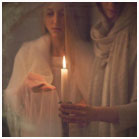|
The Raven: between
Lugh and Bran
(© Argante – Arc’Hant
Afallon Alarch)
Black wings, sharp beak, a
stern gaze. It flies over battle, caws in
churchyards, covers Ireland’s green pastures and
feeds on carcasses…what negativity in the Raven.
Or so it seems…..
We are now accustomed to
consider this creature as a harbinger of doom,
or at any rate of mystery, of danger; but in
truth, what we should read in its flight are
enchantment, magic and a huge dose of power, of
course besides battle fury and death.
A perfect dualism, an
ambiguous symbolism….but related to light and
not to darkness, related to that part of hidden
light that animates our souls when we approach
to the Journey. Raven and crow, though different,
are often associated in attempts to explain
their symbolism, especially in the Celtic
tradition. To the raven and the crow are
associated deities such as Bran and his sister
Branwen (White Raven), but also as the Irish
Morrigan and the bright Lugh, and the almost
unknown Nantosuelta.
It is to Lugh that the
legend of the raven’s black feathers is
associated. The story tells that one day, having
to absent himself, the god asked the raven, his
favourite, to watch over a girl he had fallen in
love with. The girl cheated on Lugh, laying with
a shepherd and begged the raven not to say
anything…the raven agreed, but Lugh, Lord of
divination, discovered the lie and condemned the
creature to have wings as black as the night and
to obey him blindly.
Also in Greek mythology it
was the god Apollo to make its wings black as a
punishment for having stopped to wait by a
fig-tree for the figs to ripe instead of
carrying out the tasks the God had assigned (he,
too, the God of Prophecy).
It stems from here the
association of the raven with prophecy,
attribute over which Lugh presides.
To the raven is also
related the foundation of the “hill of Lugh”,
that is, the city of Lyon – Lugudunum – on whose
site a flock of ravens stopped its flight,
persuading Lugh to found his city on that
hilltop. Moreover, it was these creatures who
warned him of the arrival of the dreaded Fomors.
Linked to a positive
symbolism is Nantosuelta’s ambassador raven.
There is a depiction of this deity on a stone
bas-relief found near the Mithraeum in
Sarrebourg , in the territory that belonged to
the Mediomatrici (France, Metz area). The
Goddess is depicted with a divine consort and
the raven stands below them. The name
‘Nantosuelta’ may signify “winding river” and in
all her depictions she is accompanied by a raven
and by prosperity and healing symbols . Bees,
sceptres, honeycombs seem to link the goddess to
the hearth, while another symbol, the cauldron,
identifies her as a goddess of regeneration, to
whom the raven is well suited because, as a
dead-eater, it speaks of death not as a ruthless
event but as soul regeneration.
The confusion between raven
and crow is probably due to the imagery
connected to the two birds, it is very hard to
tell one depiction from the other. They are
both dead-eater birds as earlier explained:
could this be the origin of the grim fame of the
raven? Maybe so. After all it is not only linked
to Lugh’s light but also to the Morrigan’s
battle horror, in the figure of Badb Catha (the
battle raven). Its apparition in the Irish tale
of Cù Chulain is yet again negative. Our hero
meets the gorgeous Goddess Morrigan who offers
him sexual favours, the young man spurns her and
the goddess disappears, showing up later as a
crow perched on a tree. From then on Cù Chulain
is relentlessly persecuted and, at the moment of
his death, the goddess will land on his shoulder
in the guise of a raven.
Anyway, this creature is
eventually linked to light as, even though
dreadful, it leads the souls, it is a guide to
knowledge and to the Otherworld.
Two more positive and
bright deities related to the raven are Bran
Vendigeit (Bran the Blessed) and his sister
Branwen (White Raven). ‘Bran’ in Welsh means
‘raven’ but sometimes it can refer to ‘top,
height, hill’ but more in the sense of ‘chief,
lord’. Bran is the Lord who owns the Cauldron of
Regeneration. It is a thoroughly positive god.
An Earth King, a faithful companion, a Great
Warrior, he is the One upon whom the nation is
founded. IN the Mabinogion (collection of
stories where his tale is told) he is the king
who cannot live in a house owing to his gigantic
size. This really indicates how he can be a
shelter and a protector. His sister Branwen is
in the same way a wonderful creature, of
unattainable beauty, love and earth goddess. She
represents the Centre in the Avalonian Tradition.
How much positivism then
in this sharp-beaked, black creature… In Italy
as in Greece, it is an emblem of longevity .
By closely scrutinizing the myths of many
countries, it appears how the raven represents
the dark side of the psyche which, if guided and
listened to, brings to growing and to fruitful
experiences.
Perhaps we could start
again to watch its flight not with dread but
with curiosity, after all the ancients used to
foretell the course of future events by watching
it…
Traduzione a
cura di Abigail_derwen
|
![]()


